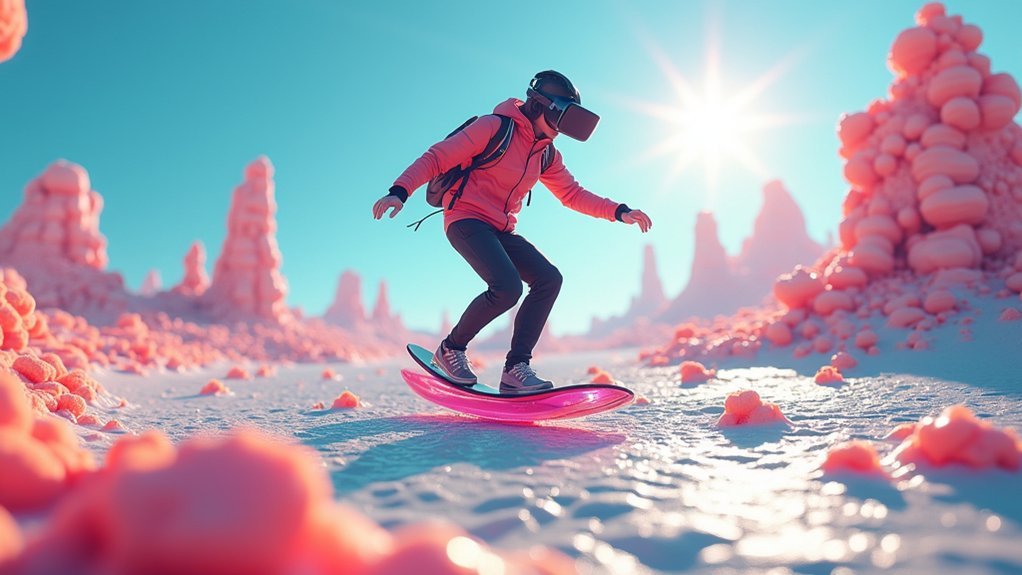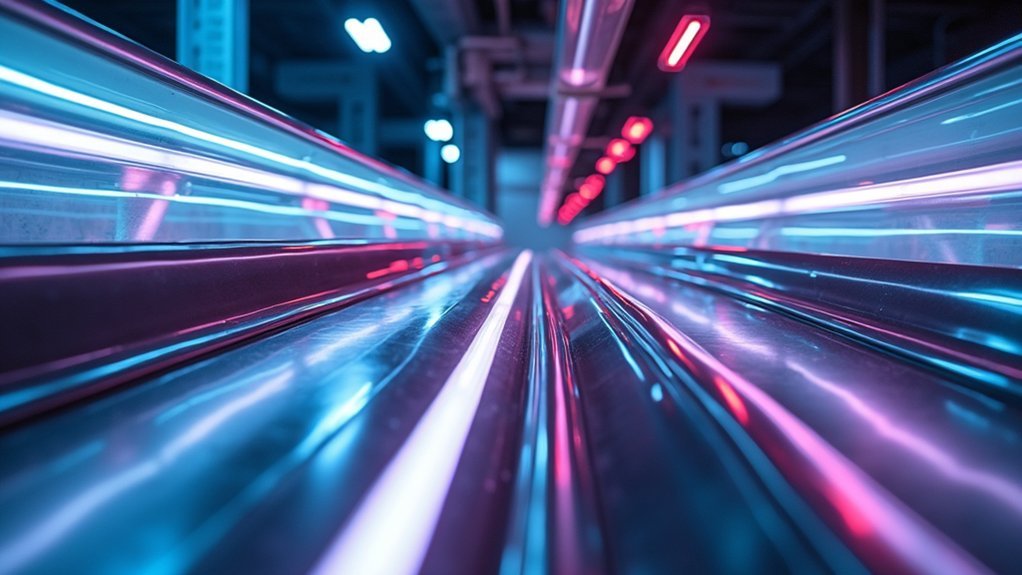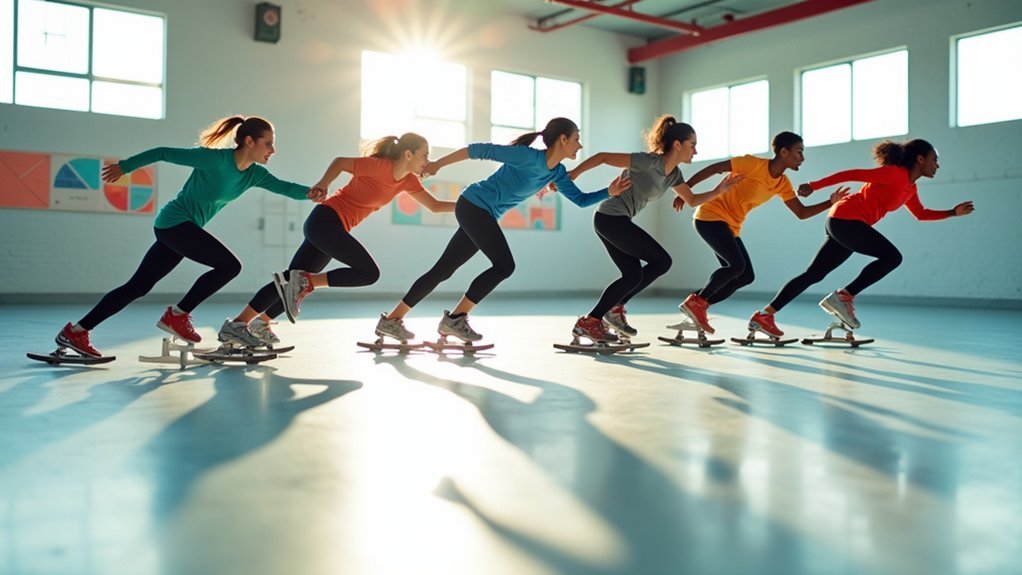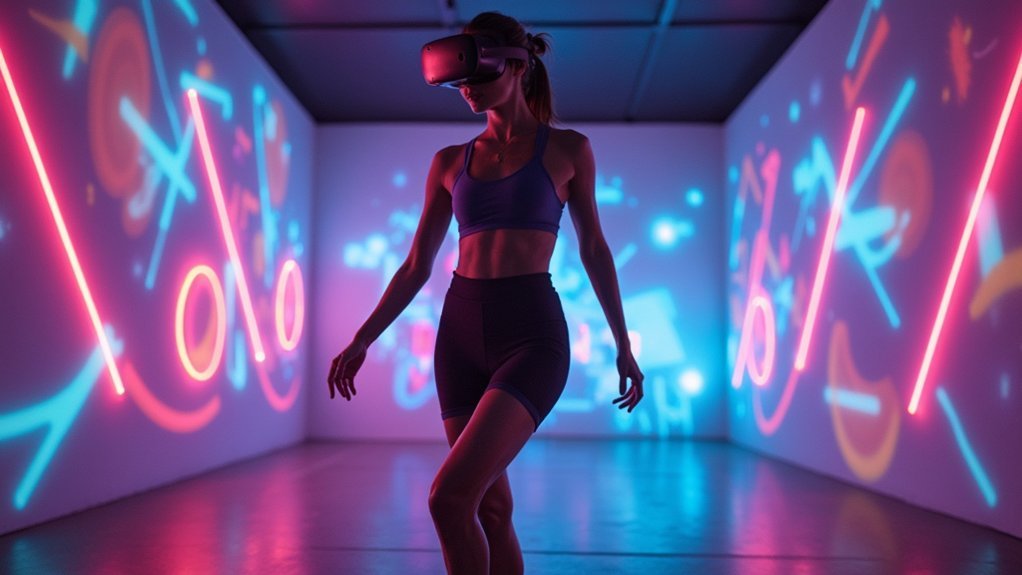You’ll master slide locomotion by adjusting controller sensitivity to match your comfort level—use lower settings (1-3) for precision and higher ones (7-10) for competitive play. Focus on smooth weight transfer between legs while engaging your core muscles for stability. Implement gradual acceleration curves with visual markers to improve control during speed changes. Calibrate movement speed based on your fitness level and preferences, while ensuring collision detection systems use real-time obstacle scanning. These foundational techniques will reveal advanced optimization strategies.
Understanding the Mechanics of Slide Locomotion in VR

When you engage in slide locomotion within virtual reality, your body coordinates complex movements that mirror real-world lateral motion patterns. This technique requires seamless weight transfer between your legs while your upper and lower body work together to maintain balance.
Your core muscles play a critical role, stabilizing your frame and ensuring fluid movement through the virtual environment. Effective slide locomotion depends heavily on your spatial awareness—you must constantly assess your surroundings to navigate smoothly and avoid obstacles.
Haptic feedback enhances this experience by simulating ground resistance and contact sensations, helping you gauge movement accuracy. Maintaining proper alignment and posture throughout the motion is essential, as it reduces virtual motion sickness and maximizes comfort during your immersive VR experience.
Optimizing Controller Input Sensitivity for Smooth Movement
Although mastering the physical mechanics of slide locomotion forms the foundation of VR movement, you’ll find that fine-tuning your controller input sensitivity can greatly transform your virtual experience from clunky to seamless. Lower sensitivity provides enhanced precision for controlled movements, while higher settings enable quicker responses.
| Sensitivity Level | Best For |
|---|---|
| Low (1-3) | Precise navigation, detailed tasks |
| Medium (4-6) | Balanced gameplay, general use |
| High (7-8) | Fast-paced action, quick turns |
| Very High (9-10) | Competitive gaming, rapid responses |
Experiment with different sensitivity settings to discover your ideal settings. Use in-game practice areas to test adjustments and match your playstyle. Regularly revisit these configurations as your skills develop—this ongoing refinement considerably improves overall performance in slide locomotion systems.
Implementing Acceleration and Deceleration Curves

Since controller sensitivity sets the foundation for responsive movement, you’ll discover that implementing proper acceleration and deceleration curves transforms basic slide locomotion into a fluid, natural experience.
You’ll need to master gradual speed increases from stationary positions through controlled push-offs that enhance your overall performance. As you shift between acceleration and deceleration phases, engage your core muscles to maintain proper balance and posture while reducing speed safely.
Focus your training on start-stop movement drills that improve your ability to execute smooth curves between speed changes. Use visual markers during practice sessions to identify your acceleration and deceleration points, allowing better control and speed adjustment throughout slides.
This approach guarantees you’ll achieve ideal fluid movement patterns.
Designing Intuitive Hand Gesture Recognition Systems
You’ll need robust gesture recognition algorithms, particularly convolutional neural networks, to accurately interpret hand movements in your slide locomotion system.
Your algorithm’s performance depends heavily on training with diverse datasets that capture gestures under various lighting conditions and backgrounds.
When designing the user interface, you must prioritize real-time processing capabilities and consider implementing depth sensing technology to enhance recognition accuracy in 3D space.
Gesture Recognition Algorithms
When you’re developing slide locomotion movement systems, gesture recognition algorithms serve as the critical bridge between your hand movements and the system’s response. Machine learning techniques process visual data from cameras and sensors to interpret your gestures accurately.
You’ll need algorithms that combine convolutional neural networks for automatic feature extraction with dynamic time warping to align gesture sequences properly. Real-time processing remains essential, requiring sub-100 millisecond latency for seamless interaction.
Multi-modalities enhance accuracy by combining different data sources:
- Visual cameras for capturing hand movement patterns
- Depth sensors for three-dimensional spatial awareness
- Accelerometers for motion detection and orientation tracking
Your gesture recognition system’s accuracy depends on robust algorithms that can handle varied environments while maintaining consistent performance across different users and lighting conditions.
User Interface Design
Although gesture recognition algorithms provide the technical foundation, your user interface design determines whether users can actually interact with slide locomotion systems effectively.
You’ll need clear feedback mechanisms that provide visual or auditory signals when gestures are recognized or misunderstood. This immediate response helps users adjust their movements and builds confidence in the system.
Incorporate ergonomic considerations to accommodate diverse users and guarantee gestures remain comfortable during extended use.
Your system should differentiate between intentional commands and accidental movements through robust filtering.
Machine learning techniques can enhance accuracy by training on varied gesture datasets, but your interface must translate this improved recognition into intuitive user experiences that feel natural and responsive.
Calibrating Movement Speed Based on User Preferences

How can you guarantee that slide locomotion systems accommodate the diverse speed preferences of different users? Calibrating movement speed requires careful consideration of user preferences and individual capabilities.
You’ll need to assess each person’s age, fitness level, and comfort levels to establish appropriate baseline speeds.
Implement these essential calibration strategies:
- Monitor physical responses during initial sessions to identify suitable speed ranges
- Utilize feedback mechanisms like visual cues to help users self-regulate their pace
- Experiment with surface materials to understand how different textures affect speed and control
You should establish gradual speed progression protocols, allowing users to start slowly and build confidence.
This approach guarantees everyone can enjoy slide locomotion while maintaining safety and comfort throughout their experience.
Creating Visual Feedback Systems for Enhanced Spatial Awareness
Since proper spatial awareness forms the foundation of safe slide locomotion, you’ll need robust visual feedback systems that provide real-time information about your body position and movement patterns.
Incorporate mirrors in your training environment to visually track your movements and improve body alignment and technique. Use video recordings to analyze your performance afterward, enabling thorough self-assessment and targeted improvements.
Visual feedback through mirrors and video recordings enables precise movement tracking and performance analysis for enhanced slide locomotion mastery.
Place colored markers or cones on the ground to create clear visual cues for spatial orientation, helping you understand your movement pathways during slide locomotion.
Regular integration of visual feedback during practice sessions will greatly boost your confidence and proficiency in executing movements effectively. These systems allow you to adjust your locomotor actions accordingly, ensuring ideal performance and safety throughout your slide locomotion training.
Minimizing Motion Sickness Through Movement Prediction
Why does your brain sometimes rebel against the very movements you’re trying to master? Motion sickness occurs when your vestibular system conflicts with visual input during slide locomotion. Your brain struggles to reconcile these mixed signals, triggering nausea and dizziness.
Movement prediction is your strongest defense against these symptoms. By anticipating trajectory changes, you’ll help your brain process sensory information more effectively. Controlled locomotor activities enhance proprioceptive awareness, improving your body’s ability to predict upcoming movements.
Implement these gradual exposure techniques:
- Start slowly – Begin with gentle slides before increasing speed
- Focus on visual cues – Use landmarks to predict movement patterns
- Maintain consistent practice – Regular exposure builds tolerance
Visual cues serve as anchors, stabilizing your visual system while your vestibular system adapts to slide movements.
Developing Collision Detection for Safe Virtual Navigation
You’ll need robust real-time obstacle detection systems that continuously scan your virtual environment to prevent collisions during slide locomotion.
These systems must integrate ray-casting techniques and bounding box algorithms to create accurate spatial awareness around your moving avatar.
Your safety protocols should include immediate response mechanisms that halt or redirect movement when obstacles are detected, ensuring you can navigate confidently without unexpected impacts.
Real-Time Obstacle Detection Systems
When you’re traversing through virtual environments, real-time obstacle detection systems serve as your digital safety net, constantly scanning surroundings to prevent collisions before they occur. These sophisticated systems integrate multiple sensors and algorithms to create thorough spatial awareness for your slide locomotion experience.
Your navigation safety depends on three critical components:
- Sensor Integration – LiDAR, computer vision, and ultrasonic sensors work together to map your environment.
- Machine Learning Processing – Algorithms continuously adapt to changing conditions and improve detection accuracy.
- Collision Detection Response – Millisecond-level processing triggers immediate safety protocols when obstacles appear.
Whether you’re using robotics applications or augmented reality systems, these detection technologies guarantee your virtual movements remain safe and fluid. They automatically adjust your path or stop movement when potential hazards emerge.
Virtual Environment Safety Protocols
As virtual environments become increasingly complex, developing robust collision detection systems forms the cornerstone of user safety protocols.
You’ll need to implement bounding boxes and raycasting techniques for precise real-time detection, preventing unintended interactions with virtual objects or other users. This approach greatly reduces virtual accidents during navigation.
You should regularly update your collision detection algorithms to maintain peak performance as user interactions increase. Incorporating user feedback mechanisms allows you to refine systems based on individual navigation patterns and preferences.
Most importantly, you’ll want to employ adaptive collision detection that adjusts sensitivity according to your speed and proximity to obstacles. This creates a more intuitive, safer navigation experience while ensuring your virtual environment remains responsive and accommodating to diverse user needs.
Integrating Haptic Feedback for Realistic Ground Contact
While traditional slide locomotion systems rely primarily on visual cues, integrating haptic feedback transforms the experience by delivering tangible sensations that simulate authentic ground contact.
You’ll feel varying resistance levels that mimic different terrain friction, dramatically improving realism and helping you adapt your sliding techniques naturally.
Advanced actuators provide precise haptic cues corresponding to your sliding motion’s speed and angle, enhancing coordination and accuracy during complex maneuvers.
This technology offers three key advantages:
- Real-time tactile responses that correct your movements instantly
- Reduced learning curve for beginners through intuitive feedback
- Enhanced performance via improved understanding of sliding dynamics
Testing and Refining Movement Systems Across Different VR Platforms
Testing your slide locomotion system across multiple VR platforms demands rigorous evaluation of user comfort and performance metrics to guarantee consistent quality experiences.
You’ll need to monitor latency closely, keeping it under 20ms to prevent motion sickness and maintain immersion. Collect user feedback through surveys and direct observation to understand preferences for speed and responsiveness.
Focus on cross-platform compatibility by testing various hardware configurations and input methods. Different controllers and headsets can dramatically affect your system’s effectiveness.
Implement avatar calibration features that let users adjust height and movement sensitivity for enhanced user experience.
Analyze performance metrics including frame rates alongside user comfort levels. Smooth shifts and realistic physics greatly reduce motion sickness while improving overall user experience across all platforms.
Frequently Asked Questions
How to Do Sliding Locomotor Movement?
Shift your weight onto one foot while keeping the other close to the ground. Engage your core, maintain low center of gravity, and use your arms for momentum and balance coordination.
How Do You Enhance Locomotor Movements?
You’ll enhance locomotor movements by practicing lateral drills that focus on weight transfer, using visual aids to understand mechanics, and incorporating obstacle courses that make skill development both fun and functional.
What Are the Different Ways to Locomote?
You can locomote through walking, running, hopping, jumping, skipping, galloping, sliding, and crawling. Each method engages different muscle groups and coordination patterns, developing your balance, strength, and overall movement skills effectively.
What Is the Fundamental Movement Skills Sliding?
You’ll shift your weight laterally from side to side, transferring weight to one foot while the other glides along the ground, developing coordination, balance, and agility essential for sports.





Leave a Reply